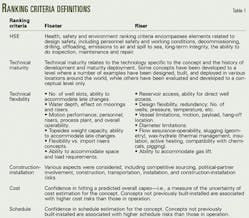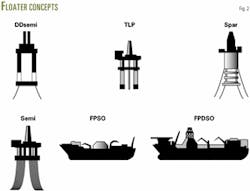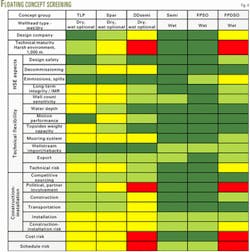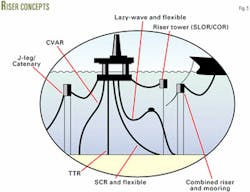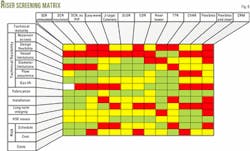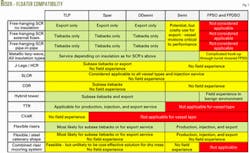Results of an evaluation clearly show that deepwater technology development for benign environments has limited use in the hostile waters of the Atlantic margin. For such environments, developers need experience with current harsh environment technology. This is more important than experience in ultradeepwater benign environments.
BP PLC and Statoil ASA reached these conclusions after evaluating the maturity and applicability of concepts for deepwater harsh-environment oil production. The evaluation included six different floating concepts, together with 13 riser systems.
The two-step ranking process involved:
- A systematic review of each concept against a number of criteria.
- Ranking of each criterion using a colored traffic-light system.
The study used 30 criteria, divided into six categories, such as:
- Health, safety, and environment (HSE).
- Technical maturity.
- Technical flexibility.
- Construction, installation cost.
- Schedule risks.
The study also established a matrix showing which riser systems are compatible with the different floating systems, based on the combined technical knowledge of BP and Statoil experts on floater and riser concepts.
Atlantic margin study
BP and Statoil are among the most experienced operators of floating production platforms and vessels in hostile waters and face deepwater harsh-environment challenges in areas on the Atlantic margin areas governed by the UK, Norway, and Faeroes.
Both companies, hence, have a strong mutual interest in field development solutions for these conditions, and therefore jointly completed this high-level screening study to address floater and riser concepts.
The study did not include any design basis other than the generic understanding of a major-size field in deepwater harsh environment at the Atlantic margin. It based the concept ranking on the following assumptions:
Water depths in the 1,000-1,200 m range.
Harsh environment similar to West of Shetland and Haltenbanken off Norway.
Reservoir type and size similar to Schiehallion and Norne fields.
The objective of the ranking study was to identify the status and maturity of different technology elements and their application range. The study, furthermore, flagged issues where the industry needs to develop new technology. This is important because sometimes there is a mismatch between what oil companies and contractor-suppliers regard as feasible, or indeed economically viable.
A team of riser and floating facility engineers from BP and Statoil met for two workshops during summer 2001. The process qualitatively reviewed a number of floating and riser concepts potentially applicable to the Atlantic margin. The resulting ranking was based on the accumulated experience and knowledge of the participants in the workshop and other colleagues who acquired this information from sources such as subcontracted work, joint industry projects (JIPs), field development projects, and operational experience.
The review is by no means comprehensive; in particular it did not address field development concepts, such as the overall development concept, subsea architecture, tiebacks, drilling alternatives, etc.
It is emphasized that this is a high-level ranking of floater and riser systems, and should be recognized as such.
Ranking process
The ranking process and the criteria included documenting the maturity of each specific concept with respect to:
- Deployment history.
- Status of the technology.
- Special challenges related to deepwater harsh environment.
Technology gaps that require development work with respect to the concept technology rather than for a specific application undertaken during a project.
The process qualitatively reviewed a number of floating system and riser concepts potentially applicable to the deepwater harsh environment. It reviewed each concept systematically against a number of criteria pertinent to the design, installation, and operability of the system. In addition, it ranked each concept against each criterion with a colored traffic-light system (Fig. 1 and Table 1).
Floaters
The study identified feasible concepts for a deepwater harsh environment reasonably quickly because of the industry's experience with deepwater developments and extensive study of various concepts over the past 10 years. The six such concept types or groups (Fig. 2) are as follows:
- Tension leg production (TLP) platform with and without drilling.
- Spar or deep-draft caisson (DDCV) production unit with and without drilling.
- Deep-draft semisubmersible (DDsemi) unit with and without drilling.
- Semisubmersible (semi) production unit with and without drilling.
- Floating production, storage, and offloading (FPSO) vessel without drilling.
- Floating production, drilling, storage, and offloading (FPDSO) vessel.
New concepts continue to appear, but these are mostly variations on the basic six themes. These new concepts also involve a long lead-time for proving acceptability in the industry and with regulatory authorities. This is particularly true for deploying new concepts in deep water and in a harsh environment. This article, therefore, does not discuss them.
The floating facility functionality covers the following five combinations:
- Wellhead platform.
- Production only.
- Production and storage.
- Production and drilling.
- Production, drilling, and storage.
The study matched these five functualities with the six concepts in a matrix shown as Fig. 3. The figure represents only the potential functionality of the concept and does indicate the technical feasibility for using it in a deepwater harsh environment.
Fig. 4 shows the main results from the ranking of floaters.
TLP
TLPs have been installed in up to a 350-m water depth in Hutton, Snorre, and Heidrun fields off the UK and Norway and up to a 1,200-m water depth in the Gulf of Mexico fields Ram-Powell and Ursa.
TLPs have the main benefit of minimizing heave response, and therefore the concept is essentially for production with dry trees. A TLP also can combine wet and dry trees or include only wet trees, but it likely is uneconomic for the latter.
The study, therefore, considered the TLP primarily for dry trees only. While a TLP provides a stable platform for drilling, it does not allow for storage of produced fluids. Also it can accommodate most riser systems because of its excellent motion characteristics.
The TLP usually is a highly optimized structure, requiring highly qualified construction yards. This fact severely restricts late changes either in well count or topsides weight.
TLP installation requires calm weather, and is thus exposed for waiting on weather.
The greatest technical risks for TLPs relate to tendon design and installation. Hence, the extreme metocean criteria combined with water depth targets encompasses significant challenges for TLPs.
Spars
The industry has installed spars or DDCVs in up to 1,460-m water depths in the Gulf of Mexico's Hoover-Diana field and has undertaken several studies on installing the structures off Northern Europe.
The spar provides a stable platform for dry trees and drilling, and the concept may also include wet trees. The design concept also can accommodate storage of produced fluids in the hull, but will require oil on water storage to be economical.
The spar concept is insensitive relative to water depth, but the risers and platform motion (heave, pitch and roll) issues in the Northern Europe metocean conditions are a challenge, and will require large riser strokes for the top-tensioned risers. The spar may accommodate most riser systems.
The spar also is an optimized structure that restricts late changes. It, however, is somewhat less sensitive to topsides weight changes than the TLP.
Completing the spar would probably require a challenging float-over deck installation in order to be competitive. Other challenges relate to inspection, maintenance and repair of hull, air-cans, risers, and keel-joint in a harsh environment location.
The greatest technical risks relate to motion behavior and mooring system design and performance.
DDsemi
The industry has not deployed any DDsemis; however, several design concepts-studies demonstrate their potential feasibility.
The DDsemi is principally for dry trees and drilling but also may include wet trees. Concept studies also have proposed storing produced fluids in the hull.
The dry-tree case has challenges related to motion (heave, pitch, and roll) and the required riser stroke.
The DDsemi accommodates most riser concepts and has less sensitivity to late changes in well count and topsides weight than TLPs and spars.
Other challenges relate to fabrication (draft, height requirement), transportation, and installation.
The greatest challenge or hurdle for the DDsemi is that it would be a "first of a kind" and the potential upside of using it may not be sufficiently great to counteract the associated risks.
Semisubmersibles
The industry regards semi technology as mature for drilling vessels in deepwater and production vessels, for harsh environments in relatively shallow water. Åsgard B in 300-m water depth in the Haltenbanken area is at present the largest production semi in operation.
The deepest moored semi was P-36 in 1,360-m water depth in the Campos basin off Brazil. The production semi for the Thunder Horse development in the Gulf of Mexico will be in deeper water, 1,840 m, and it will be larger.
Because of the motions a semi would experience in the North Atlantic, the study expects the semi concept to be considered for wet trees only, although drilling from the semi remains an option.
A semi accommodates many risers and most riser systems tailored for wet trees. Its design is less sensitive to changes in well count than TLPs and spars; however, it is sensitive to topsides weight changes and cannot accommodate oil storage.
FPSO
The industry regards FPSOs as proven technology for harsh environment such as Foinaven, Schiehallion, Norne, Åsgard A, etc. The extension of FPSOs to deepwater harsh environments will require improved mooring, riser, and turret-swivel systems. Again, due to the magnitude of FPSO motions, the study considered FPSOs only for wet-tree applications with produced fluid storage in the hull.
The FPSO can accommodate somewhat fewer riser concepts than the semi; however, it is less sensitive to late changes provided that it has sufficient slots in the turret-swivel system.
The FPSO, furthermore, is robust against late topsides weight changes, assuming adequate space is available.
FPDSO
FPDSOs extend FPSO technology by including a drilling capability. The industry has undertaken some studies on this concept but has deployed no FPDSO.
The FPDSO also was considered only for wet-tree application, with storage in the hull.
The drilling function complicates the turret and fluid-transfer system. Also the simultaneous multi-functionalities (production, drilling, and offloading), increase the design and operational complexities and the associated risks.
The largest hurdle for the FPDSO will be the same as for the DDsemi, which is the "first of a kind" risk. Its size and complexity, furthermore, imply that it will be very challenging to design, fabricate, and install on schedule and budget.
Floaters concepts
The study considers floater concepts targeting subsea completed wells as somewhat more mature than concepts for platform-completed wells. The six concepts were categorized in three groups with priority as follows:
FPSOs and semi's are relatively mature. Some issues remain that need further development, but the concepts have no major constraints.
TLPs and spars require significant development in some areas for application in harsh environment and 1,000-m water depths.
DDsemi and FPDSO concepts also require significant development in some areas, and in addition these concepts have some aspects where technical feasibility has not been confirmed or the time and cost for deployment may be excessive.
Risers
The selected riser concepts (Fig. 5) include the following five main categories:
- Flexible risers, flexible pipe only, and combined steel and flexible pipe (hybrid system).
- Top-tensioned risers (TTRs).
- Highly compliant (metallic) risers (HCRs). These include steel catenary risers (SCRs) that have single pipe with insulation, single pipe without insulation, and pipe-in-pipe (PIP) as well as lazy-wave risers; and compliant vertical access risers (CVARs).
- Hybrid risers such as J-legs/Catenary hybrid riser (CHR), riser tower, single-line offset riser (SLOR), and concentric offset riser (COR).
- Combined riser and mooring (CRM).
The riser screening exercise did not intend to rank the risers because each may serve a different purpose and apply to different floater types, but the exercise highlighted their advantages and disadvantages. Fig. 6 shows the main results.
Fig. 7 defines the assessment of compatibility between riser and floating systems. Note that it does not reflect the advantages and disadvantaged for each system as presented in Fig. 6, but it presents the overall compatibility, which is mainly related to motion compliancy, technical maturity, and installation aspects.
Flexible risers
Flexible risers are compatible with all the screened vessel types. The study considered them to be reasonably mature with a relatively well understood technology, unless the industry introduces new products (such as new materials or components, cross-section profiles, etc.).
These risers primarily are for production and injection with wet trees. Tieback of satellite wells to dry-tree platforms, however, is possible. These risers also can serve as export lines, although they have diameter limitations, which may require multiple lines.
Conventional flexible risers have considerable worldwide shallow-water experience, including harsh environments, but limited deepwater experience. These risers have short installation times that may reduce installation costs, although the pipes are fragile and therefore may require dedicated installation vessels and crew. The risers also do not have much design flexibility because they are "tailor-made" with respect to diameter, pressure, temperature, water depth, dynamics, and service application.
The risers have flow assurance issues related to slugging (shaped configurations) and thermal management because of a relatively high overall heat-transfer coefficient (U values). Other issues relate to accommodating pigging operations and chemical use.
Long-term pipe integrity is another key issue because deterioration or ageing of polymers and fatigue performance of steel components. Limited IMR (inspection, maintenance, and repair) methods amplify this issue.
Also undesirable are the high weight to tension (except for the hybrid solution with flexible and steel, or use of composite armors, both of which are new unproven products for harsh environment application) along with high pipe costs (in particular for new products) of these risers.
Top-tensioned risers
Top-tensioned risers are compatible only with floaters exhibiting low-heave motions and are applicable for dry trees on all types of wells, such as production, injection, and export. The risers may provide direct well access.
TTRs have considerable worldwide experience in deepwater benign environments on TLPs and spars, and on TLPs in shallow-water harsh environments off Norway.
The risers accommodate most flow assurance aspects well and are compatible with gas lift. Installation and fabrication practices are well established and understood, yielding low cost risks.
These risers have a downside related to well-bay spacing requirements because of riser interference, in particular clashes with the drilling riser. The high-tension requirement, furthermore, penalizes payload sensitive floaters and may raise significant hull design issues.
Also key components such as stress joints and keel joints (for a spar) face critical design issues, along with stroke requirements and design of tension providers.
Highly compliant metallic riser
The highly compliant metallic risers include several significantly different concepts.
Free-hanging steel catenary risers are sensitive to vessel motions and hence not compatible with an FPSO and FPDSO in harsh environment but may work for certain applications for a semi. Free-hanging SCRs comply best with floaters exhibiting low motions (TLP, spar, and DDsemi), with a potential use also on a semi.
Risers without insulation only are likely for export, while insulated (external foam) and PIP solutions may serve as tieback risers for production and injection.
SCR technology is relatively mature and numerous SCRs have been installed, albeit in less harsh environments. They represent relatively simple and low-cost systems (except the PIP solution).
The systems have no severe flow-assurance issues, although they represent high U-value systems (except the PIP solution), and they accommodate pigging and chemical treatment.
The industry understands well their design, fabrication, and installation, thereby lowering costs and risks. The PIP solution is an exception because of less mature design experience and analysis tools and methods. The systems have such critical areas as thermal buckling, pipe centralizers, and long-term integrity management of PIP systems.
Key issues for all SCR systems relate to fatigue, soil-structure interaction, vortex induced vibrations (VIV), upper termination (stress-flex joint), and welding procedures linked to fatigue performance.
Pre-installation of the systems is not considered possible, and this may affect schedules, particularly if a project has many SCRs.
The lazy-wave steel riser exhibits good in-place motion performance and could be used for different applications on all vessels. Tie-in, however, to an FPSO or FPDSO turret is complicated.
The study considers the compliant vertical-access riser only for heave-restrained floaters (TLPs), where they may serve as production and injection risers. It offers direct access with step out of wells. These risers have the same key issues as raised for SCRs and TTRs, but they have less fatigue and risen interference concerns.
The riser tension and hence impact on payload are lower than for TTRs.
The riser offers good flow-assurance properties and easily can accommodate gas lift. Its main drawbacks relate to accommodating a large density variation and riser buckling, installation (requiring floater to be pushed-pulled over), and mooring restrictions (including riser-mooring clashing).
It also has a high risk because of the lack of a track record. Only desk studies have been made on the concept.
Hybrid risers
Hybrid riser systems also have several systems that vary significantly. They, however, do have in common the same advantages and disadvantages offered by the flexible risers.
All vessels may consider hybrid riser systems. Field experience in deepwater benign environment, however, only exists for the riser-tower alternative, which may serve as a subsea tieback for production and injection.
Hybrid risers may also serve as export solutions, although there may be some diameter limitations on the flexible jumpers, requiring multiple lines.
All vessel types can accommodate the J-legs/Catenary hybrid riser system, although no field experience exists. The system consists of well understood and mature components. The SCR response is decoupled from vessel motions but susceptible to localized VIV induced fatigue. The system can be partly pre-installed, thus reducing schedule risks (SCRs and long lead items such as the buoyancy tank). Multiple vendors and fabrication yards can provide the systems.
The disadvantages of these systems relate to poor flow-assurance properties because of potentially severe slugging, limited remediation means (chemicals and pigging restrictions of flexibles), and complicated gas lift system.
Key critical issues are long-term integrity of the tank and flexible jumpers, erosion of goosenecks, and installation of the tank and risers in a confined area.
All vessel types can include riser tower systems, and SLOR and COR concepts. These systems also can accommodate easily gas lift at the riser base.
The systems consist of well-known components, except the COR concept that has similar design challenges as the PIP solution. Because they can be partly pre-installed, the systems have reduced scheduling risks.
Riser towers in less harsh environments have a track record. But it would not be recommended to have a dual structural and flow-path role for central pipe or a dual insulation-buoyancy role for the tower in harsher environments.
The SLOR and COR concepts can be added when needed, whereas the riser tower has limited inbuilt redundancy.
Key critical issues are long-term integrity and IMR of flexible jumpers, flow assurance (slugging, thermal properties, restricted pigging operations and use of chemicals), VIV fatigue of vertical section and installation (if towed, imposing weld fatigue issues versus using threaded connections not being qualified).
Combined riser, mooring
The combined riser and mooring system is an innovative solution, which is considered applicable for spread-moored FPSOs in benign environments, but less compatible with a weather-vaning FPSO in harsh environments because of significant dynamic loads in the SCR risers.
Although technically feasible for TLP, spar, DDsemi and semi, the systems are unlikely to be cost-effective and they lack field experience. Furthermore, they are unlikely to be installed with a TLP, spar, or DDsemi.
Their main benefits are a saving of mooring-line costs and the fact that the systems may be partly pre-installed.
Critical areas include combined use of riser and mooring (potential regulatory issues), tether design (including snatch loads), vessel-buoy-riser interactions, long-term integrity, complexity of buoy, and installation complexity and risks.
Also, flexible jumper design and capabilities have potential limitations.
Considerations
The technical challenges of deepwater harsh environments are more similar to those already faced in existing (relatively shallow) harsh environment developments than to those for existing deepwater developments in mild environment. One, therefore, should mainly use the harsh-environment experience as the starting point for new developments in deepwater harsh environment.
At present, concepts that target subsea completed wells are somewhat more mature than concepts for platform completed wells. This implies that more effort must be put into dry-tree than wet-tree solutions in order to achieve comparable maturity between the two main categories.
One can combine several riser systems with the different floater concepts. The dry-tree units provide more flexibility to the riser designer than motion exposed floaters used for wet trees. A variety of riser systems is needed because of various service applications and fluid properties.
Recommendations for development work for each concept are inherent in the colors used in the figures, as follows:
Dark green—This technology is applicable to deepwater harsh environments with some limited development work.
Light green—This technology is applicable to deepwater harsh environment, but it needs more extensive development work.
Yellow—This technology has a high priority for development to improve the concept's maturity.
Red—This technology needs more extensive development and requires an estimation of the development time and cost.
It is essential to recognize that the ranking matrix should not be read in isolation from the text of this article that explains the discussions at the workshops and sets the context and rationale behind the assigned colors in the ranking matrix.
Use of the ranking matrix in isolation can be misleading.
Based on a presentation to the Deep Offshore Technology International Conference and Exhibition, Nov. 13-15, 2002, New Orleans.
The authors
Arnt Olufsen is a chief researcher-production systems for Statoil ASA. He previously worked for SINTEF (The Foundation for Scientific and Industrial Research at the Norwegian Institute of Technology). Currently at Statoil, he is involved in R&D planning and management of field development technology. Olufsen has an MS in structural engineering and a PhD from the department of marine structures of the Norwegian Institute of Technology.
Geir Løland is a chief engineer-platform technology for Statoil ASA. He is involved in technical reviews and the decision processes for all offshore projects in the company's worldwide portfolio. Prior to Statoil, he worked for Det Norske Veritas (DnV) and MARINTEK. Løland has a PhD in marine hydrodynamics.
Peter Gorf is a structural/floating systems engineer in the deepwater facilities team in BP PLC's upstream technology group. He focuses on development of floating concepts for deepwater development with particular emphasis on FPSOs. Gorf has a PhD in structural engineering and is a Chartered Engineer.
Simon Webb is part of the deepwater facilities team in BP PLC's upstream technology group and currently is working on riser design for BP's Atlantis development in deepwater Gulf of Mexico. Since 1999, he has been responsible for a number R&D projects relating to riser technology and field development concept selection.


